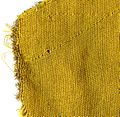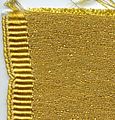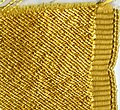Cloth of gold
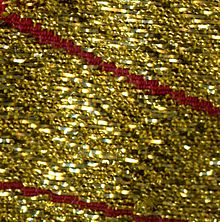
Cloth of gold or gold cloth (Latin: Tela aurea) is a fabric woven with a gold-wrapped or spun weft—referred to as "a spirally spun gold strip". In most cases, the core yarn is silk, wrapped (filé) with a band or strip of high content gold. In rarer instances, fine linen and wool have been used as the core.
History
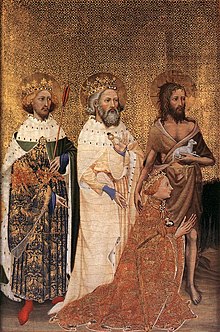
While cloth of gold has been popular for ecclesiastical use for many centuries, the earliest mentions of the use of cloth of gold are found in Vedic texts of South Asia. Earlier uses can be traced back to Central and South Asia where ancient Irani peoples have mentioned use of a fabric woven with gold. In eastern Asia, Chinese weavers had also used the technique of weaving gold into silk fabrics to create designs. Under Henry VII of England, its use was reserved to royalty and higher levels of nobility. Cloth of gold continued to be the fabric of choice for royalty, nobility and the elite across the globe for centuries as a show of wealth and power. India continues the tradition as was recently demonstrated in the Ambani family weddings.[1] It is also used today by companies such as Charvet for neckwear.[2]
Few extant examples have survived in Roman provincial tombs.[3][4][5] Later producers of cloth of gold include the Byzantine Empire and Medieval Italian weavers, particularly in Genoa, Venice and Lucca.[6] Dating from the 1460s the Waterford cloth-of-gold vestments are made from Italian silk woven in Florence. The panels were embroidered in Bruges which was the centre of the medieval embroidery industry. A similar cloth of silver was also made. It is still made in India and Europe today.[7]
Use at Coronation of King Charles III
King Charles III re-used the Supertunica made from cloth of gold at his coronation on 6 May 2023. The full-length, sleeved coat is an important historic textile from the royal collection, weighing around two kilograms. It has been worn at several previous coronations in the United Kingdom.[8]
Other
- Cloth of gold is not to be confused with various goldwork embroidery techniques that date back to antiquity, though the type of goldwork thread called "passing" is identical to the weft thread of cloth of gold.
- Most modern metallic fabrics made in the West are known as lamé.
- Cloth of gold is a familiar name occasionally applied to the venomous Conus textile species of cone shell.[9]
- Tilsent is a luxurious silken cloth interwoven with flattened threads of gold or silver.[10]
Images
- satin-weave cloth of gold, front
- satin-weave cloth-of-gold, back
- twill-weave cloth-of-gold, front
- twill-weave cloth-of-gold, back
See also
References
- ^ Hayward, Maria (2009). Rich apparel: clothing and the law in Henry VIII's England. Ashgate Publishing. p. 172. ISBN 978-0-7546-4096-7.
- ^ Misener, Jessica (2017-12-06). "Real Gold Necktie Developed In Switzerland Will Cost You $8,500 (PHOTOS)". HuffPost. Retrieved 2023-04-19.
- ^ GATH, JOSEPH; RAHMANI, L.Y. (1977). "A Roman Tomb at Manaḥat, Jerusalem". Israel Exploration Journal. 27 (4): 209–214. ISSN 0021-2059. JSTOR 27925635.
- ^ Waters, Conny (2022-08-13). "Unique Ancient Gold Cloth Found In The Necropolis Of Saint-Pierre-l'Estrier Is The Largest Antique Piece Found To Date". Ancient Pages. Retrieved 2023-04-19.
- ^ Hart, Mary Louise; Ganio, Monica; Maish, Susan Lansing; MacLennan, Douglas Kainoa (2021-08-30). "Vittae Auratae: Interpreting the History and Technology of a Group of Roman Gold Textile Fragments". ResearchGate. Retrieved 2023-04-19.
- ^ Jane Burns, E. (2009). Sea of silk: a textile geography of women's work in medieval French literature. University of Pennsylvania Press. p. 47.
- ^ "Cloths of Gold: National Institute of Fashion and Technology". Google Arts & Culture. Retrieved 2023-04-19.
- ^ Harris, Rob (2 May 2023). "Charles to recycle robes and thrones for more sustainable coronation". The Sydney Morning Herald.
- ^ "Cloth-of-Gold". Eyefetch. Archived from the original on 2012-02-10.
- ^ Guy, John (2014). Henry VIII : the quest for fame. London: Allen Lane. p. 82. ISBN 9780141977126.
- The Roman Textile Industry and Its Influence. A Birthday Tribute to John Peter Wild. Edited by Penelope Walton Rodgers, et al.
Bibliography
- Joycelyne Gledhill Russell: The Field of Cloth of Gold: Men and Manners in 1520. Routledge & Kegan Paul, London 1969
External links
- Priest-Dorman, Carolyn (March 2002). "Some More Medieval Linen Weaves" (PDF). Medieval Textiles (31): 1, 5–7. ISSN 1530-762X.


